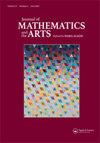Generative Art
IF 0.2
Q4 MATHEMATICS, INTERDISCIPLINARY APPLICATIONS
引用次数: 149
Abstract
As an artist, I have the freedom to subject myself to restrictive rules that may run close to what is understood by a ‘program’ in computer science. Sentences like: ‘use only vertical strokes of roughly the same length’, ‘go to and fro along a given contour’, ‘draw a tree with short, violent strokes’, etc., are examples for such ‘programs’. In Generative Art (for a definition see, for example, Galanter, 2003), explicit use is made of such rules. I describe my attempts as ‘an art practice where the artist follows a self-designed system of formal rules’ (Dehlinger, 2007). Working manually on a physical piece in statu nascendi, artists have an immediate feedback on the impact of any stroke or action they perform. Not so in Generative Art. Here an idea or a concept is in the focus for which a specific production system is designed that will turn out an aesthetic event. The artist, the inventor of the generative system, then judges it. The strictness of the rules and the precision in their execution performed by the computer are unparalleled. But, in my eyes the machine does not conceive the art. The artistic intelligence/creativity is seated facing the computer and not within it. Accepting the computer as part of the art making equation, artists are granted the privilege to explore totally new and hitherto unknown domains. Generative Art has a strong relation to design. But contrary to design proper, where usually one (in the eyes of the designer the optimal) instance for implementation is searched for, the emphasis in Generative Art is on the plural. The generating system – and this is a wanted effect – is in principle able to supply an endless sequence of differing results, all within the constraining rules set out – a fantastic playground for art. The problematic issues on programming for art related themes in architecture, design and art have engaged me since I started with programming with Algol 68 in the early 60ies as a student of architecture at the University of Stuttgart, Germany. As students of architecture we also were part of a multidisciplinary Studium generale listening to the lectures on aesthetics of the philosopher Max Bense. It was in this context where I first encountered the computer art pioneer Frieder Nake, working on a Zuse-Graphomat. In 1969, I entered the UC Berkeley as a graduate student thanks to a scholarship by DAAD. And, an unforgettable experience shortly after my arrival was an extensive visit of the Cybernetic Serendipidy exhibition at the San Francisco Exploratorium (Reichardt, 1968).生成的艺术
作为一名艺术家,我可以自由地让自己受制于限制性规则,这些规则可能与计算机科学中的“程序”所理解的规则非常接近。像这样的句子:“只使用大致相同长度的垂直笔画”,“沿着给定的轮廓来回走动”,“用短而猛烈的笔画一棵树”等等,都是这样的“程序”的例子。在生成艺术(如galante, 2003)中,明确使用了这些规则。我将我的尝试描述为“艺术家遵循自己设计的正式规则系统的艺术实践”(Dehlinger, 2007)。手工制作处于萌芽状态的实物作品,艺术家可以立即反馈他们执行的任何笔画或动作的影响。而生成艺术却不是这样。在这里,一个想法或一个概念是重点,一个特定的生产系统被设计出来,将变成一个美学事件。艺术家,生成系统的发明者,然后判断它。计算机执行规则的严格性和精确性是无与伦比的。但是,在我看来,机器并没有构思出艺术。艺术智慧/创造力是面向电脑的,而不是在电脑内部。接受计算机作为艺术创作方程式的一部分,艺术家被授予探索全新和迄今未知领域的特权。生成艺术与设计有很强的关系。但与通常只寻找一个(在设计师眼中是最佳的)执行实例的适当设计相反,生成艺术强调的是复数形式。生成系统——这是一种想要的效果——原则上能够提供一系列不同的结果,所有这些结果都在设定的约束规则内——这是一个神奇的艺术游乐场。60年代初,作为德国斯图加特大学的一名建筑系学生,我开始使用Algol 68编程,开始研究建筑、设计和艺术中与艺术相关主题的编程问题。作为建筑专业的学生,我们也参加了一个多学科的综合工作室,听哲学家马克斯·本斯(Max Bense)的美学讲座。正是在这种背景下,我第一次遇到了计算机艺术先驱Frieder Nake,他正在制作Zuse-Graphomat。1969年,我凭借DAAD的奖学金进入加州大学伯克利分校攻读研究生。而且,在我到达后不久,一个难忘的经历是在旧金山探索博物馆广泛参观了控制论Serendipidy展览(Reichardt, 1968)。
本文章由计算机程序翻译,如有差异,请以英文原文为准。
求助全文
约1分钟内获得全文
求助全文
来源期刊

Journal of Mathematics and the Arts
MATHEMATICS, INTERDISCIPLINARY APPLICATIONS-
CiteScore
0.50
自引率
0.00%
发文量
19
 求助内容:
求助内容: 应助结果提醒方式:
应助结果提醒方式:


